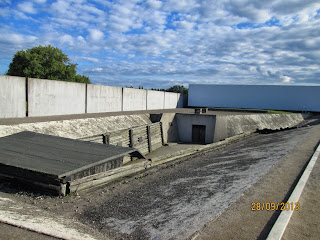We set off to find breakfast at a leisurely pace, we were looking for Assel where, according to my Lonely Planet, 'both the seats and the toilets
are kooky', the café
had been long closed. Oh well, we resorted to the expensive, wasp-plagued but
quite tasty, Oranium, unknowingly munching on melons in the heart of the
prostitution area.
From here we jumped on the S1 to Oranienburg. The
journey took about an hour, it was a sensationally sunny day. We watched the
landscape becoming increasingly rural and the proliferation of summer houses
for the enjoyment of all those urban Berliners. It felt like a great day to be alive and
yet my mind was already conscious of where we were headed, and of the 20,000
people who had met premature deaths travelling this same route.
(S1)
Sachsenhausen
We were en route to Sachsenhausen concentration camp.
I’d never been to a concentration camp before, I was frightened of the unknown and didn't want to go alone. But with my trusty companion at my side and lots of head knowledge from my MA course I approached the site with
trepidation.
The first thing I noticed was they don’t charge an entry
fee. This is not entertainment for tourists, this is education and no one is to
be barred due to cost. Secondly you could opt to buy an audio guide; they
fascinate me, the way they mediate your experience of historical sites, shaping
the narrative and indeed my own experiences. I think the audio-guide helped to
distance me from the very immediate emotions of being in such a place of death;
audio-guides are usually reserved for country houses and battlefields long
since disappeared.
The site itself is mainly levelled to the ground – with
concrete demarcations of huts and other buildings. Some elements have been
reconstructed such as a domestic hut so you can get a sense of scale and
representative watch-towers. It is always difficult to know how to make
monuments of these contested spaces; do you let them crumble or do you preserve
them for posterity? I found the
truck depot and mass-grave complex the most harrowing – all life and vitality
had been totally quenched here in some very cruel ways.
Did you know that when the Russian liberators arrived they
continued to use the camp to intern prisoners? They uncovered a mass grave of
prisoners’ bodies in the 1990s.
Humans can be hideous.
Schloss Oranienburg
We headed for Schloss Oranienburg led on by the
sounds of medieval instruments. It was a bit pricey to get in to the festival but we noted Oranienburg had a pretty river, castle, gardens and a
strange Russian shop. Our return journey was rather quiet.
(Schloss Oranienburg)
(Russian shop)
Mexikanische Essen
For dinner we returned to Warschauer Strasse (where I stayed
last year) on the u-bahn; trying not to meet the eyes of those begging ‘change
for joints’.We navigated our way through the stoned hipsters to Simon-Dach Strasse, a street lined with restaurants and
came across this Mexican restaurant where we maxed out on burritos and
cocktails. Great value, epic portions and tasty cocktails, A+.






No comments:
Post a Comment